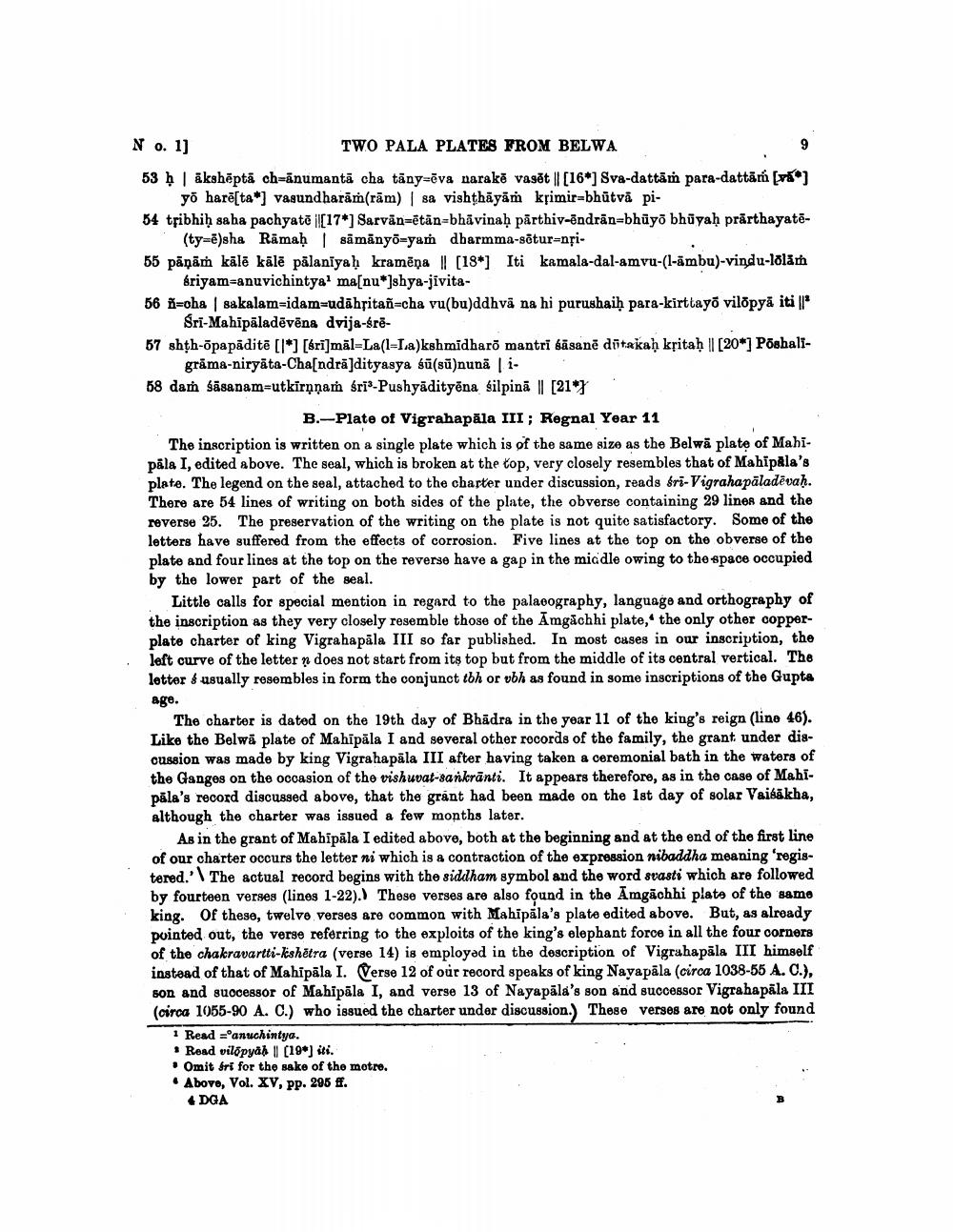________________
No. 1]
TWO PALA PLATES FROM BELWA 53 h | ākshēptă ch=ānumantā cha tāny=ēva narakē vasēt || [16*] Sva-dattāṁ para-dattām (vá)
yo harē[ta*) vasundharām(rām) | sa vishthāyām krimir=bhūtvā pi54 tribhiḥ saha pachyatē ||[17*] Sarvān=ētān=bhāvinaḥ pārthiv-ēndrān=bhūyo bhūyaḥ prārthayatē
(ty=ē)sha Rāmaḥ samānyõ=yam dharmma-setur=nți55 pāņām kālē kālē pālanīyaḥ kramēņa || (18*] Iti kamala-dal-amvu-(l-āmbu)-vindu-lolan
briyam=anuvichintyal ma[nu*]shya-jivita56 x=oha sakalam-idam=udāhsitañ=cha vu(bu)ddhva na hi purushaiḥ para-kirttayo vilopyā iti |
Sri-Mahīpāladēvēna dvija-śrē57 shth-õpapāditē [l*] [brī]māl-La(I=La)kshmidharo mantrī sāsanē ditakaḥ kritah || [20*] Põshali
grāma-niryāta-Cha[ndrā]dityasya sū(sū)nunā | i. 58 dam śāsanamrutkirņnam śrī-Pushyādityēna silpinā || [2107
B.--Plate of Vigrahapāla III; Regnal Year 11 The inscription is written on a single plate which is of the same size as the Belwā plate of Mahipala I, edited above. The seal, which is broken at the top, very closely resembles that of Mahipala's plate. The legend on the seal, attached to the charter under discussion, reads fri-Vigrahapāladēvaḥ. There are 54 lines of writing on both sides of the plate, the obverse containing 29 lines and the reverse 25. The preservation of the writing on the plate is not quite satisfactory. Some of the letters have suffered from the effects of corrosion. Five lines at the top on the obverse of the plate and four lines at the top on the reverse have a gap in the middle owing to the space occupied by the lower part of the seal.
Little calls for special mention in regard to the palacography, language and orthography of the inscription as they very closely resemble those of the Amgachhi plate, the only other copperplate charter of king Vigrahapāla III so far published. In most cases in our inscription, the left curve of the letter n does not start from its top but from the middle of its central vertical. The letter & usually resembles in form the conjunct tbh or vbh as found in some inscriptions of the Gupta age.
The charter is dated on the 19th day of Bhadra in the year 11 of the king's reign (line 46). Like the Belwā plate of Mahipäla I and several other rocords of the family, the grant under discussion was made by king Vigrahapäla III after having taken a ceremonial bath in the waters of the Ganges on the occasion of the vishuvat-sankrānti. It appears therefore, as in the case of Mahipāla's record discussed above, that the grant had been made on the 1st day of solar Vaisakha, although the charter was issued a few months later.
As in the grant of Mahīpāla I edited above, both at the beginning and at the end of the first line of our charter occurs the letter ni which is a contraction of the expression nibaddha meaning 'registered. The actual record begins with the siddham symbol and the word svasti which are followed by fourteen verses (lines 1-22).) These verses are also found in the Amgāchhi plate of the same king. Of these, twelve verses are common with Mahipala's plate edited above. But, as already pointed out, the verse referring to the exploits of the king's elephant force in all the four corners of the chakravartti-kshetra (verse 14) is employad in the description of Vigrahapāla III himself instead of that of Mahipala I. Verse 12 of our record speaks of king Nayapāla (circa 1038-55 A. C.), son and successor of Mahipāla I, and verse 13 of Nayapāla's son and successor Vigrahapāla III (circa 1055-90 A. C.) who issued the charter under discussion.) These verses are not only found
1 Read ='anuchintya. . Read vilopyah || (19*) iti. • Omit fri for the sake of the motre. • Above, Vol. XV, pp. 295 ff.
4 DGA
.




